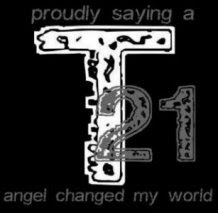To do my part for Down Syndrome Advocacy and Awareness, I've committed to blogging for the "31 for 21" challenge (31 days of blogging for Trisomy 21). That means I'll be blogging about Down Syndrome for each of the 31 days of October.
Down Syndrome is medically known as Trisomy 21. That means that the 21st chromosome accidentally over duplicates itself and presents extra chromosomal material in varying amounts and places throughout the body. How much and where this extra chromosomal material ends up varies from individual to individual as does the outward affect on the individual.
Down Syndrome is genetic. That means it's in the DNA. But, it is NOT hereditary. It doesn't run in families. However, my risk of having another child with Down Syndrome increases if I've already had a child with Down Syndrome. I guess that means my body may make the same mistake twice. After all, I'm only human and "to err is human"!
Down Syndrome is not any one's fault and it cannot be prevented from happening. At this point, no one knows why it occurs. Only that it is completely by accident and can happen to anyone at any age. While there is all kinds of research going on to examine the why with an eye toward prevention, there is as much research on the widely varying outcomes which are vastly affected by hormones and environment -- external factors including medical treatment and early intervention. This research shows that 2 children with exactly the same DNA (read: identical twins... like mine), both with exactly the same 21st chromosome duplication (read: Down Syndrome) may have vastly different outcomes depending upon their life experience. That is, early intervention --medical, physical, mental -- can change the outcome.
Years ago, individuals with Down Syndrome were institutionalized. Today we know that people with Down Syndrome can learn to do almost anything a person without Down Syndrome can do... perhaps with a bit more help or different teaching methodology. Yesterday, they were banished from society. Today they lead productive and fulfilling lives. Imagine what we'll find out tomorrow!
Thursday, October 9, 2008
Subscribe to:
Post Comments (Atom)


















Hi Maggie, I'm a bit late joining the 31 for 21 challenge, but I'm here; and I'm very glad to see you advocating for your sons.
ReplyDeleteSmall addition to your information:
There is a form of Down Syndrome that tends to run in families. After Margret was born, the hospital pediatrician tried to frighten me into having no more children, by telling me every other child I had would also have Down Syndrome. (He was also terribly negative on other topics.)
That form is a translocation, where the long leg of a chromosome 21 has attached itself to another chromosome, often chromosome 14. Where it exists as a 'balanced translocation', you have an unaffected person, that is, one with the right amount of DNA. In this case, the chromosomes can divide up in meiosis such that there is extra material from the 21st chromosome.
Since I didn't trust the pediatrician and his motives, Margret's Dad and I sought genetic counseling when we were ready to consider another child. Since our karyotypes came back normal, the counselor said my chance of having another child with DS was about the same as it had been before I had Margret, or 1 in 600. I likened the happening to reaching into a jar containing 600 marbles, 599 white and one black, and pulling out the black marble. He found it a good example.
Remember please, that the numbers I am using were considered valid back in the early 1970s.